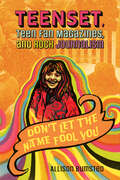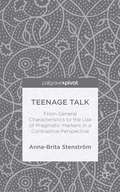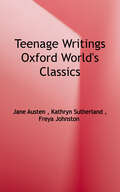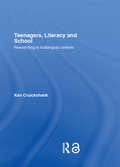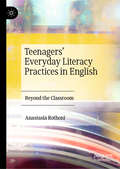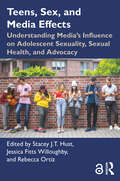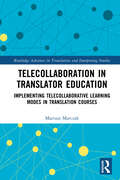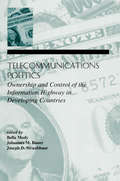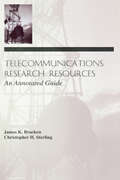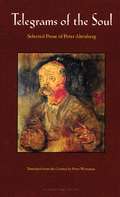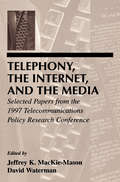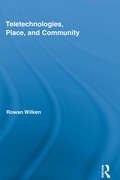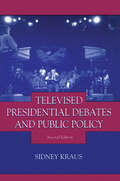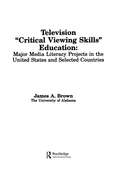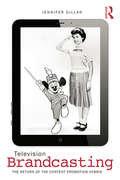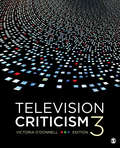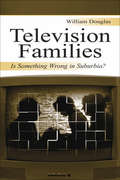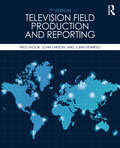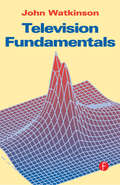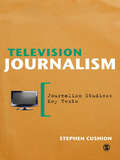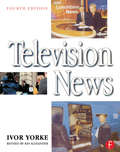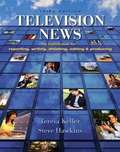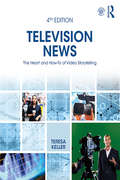- Table View
- List View
TeenSet, Teen Fan Magazines, and Rock Journalism: Don't Let the Name Fool You
by Allison BumstedSince the magazine’s first issue in 1964, TeenSet’s role in popular music journalism has been overlooked and underappreciated. Teen fan magazines, often written by women and assumed to be read only by young girls, have been misconstrued by scholars and journalists to lack “seriousness” in their coverage of popular music. TeenSet, Teen Fan Magazines, and Rock Journalism: Don’t Let the Name Fool You disputes the prevailing conception that teen fan magazines are insignificant and elevates the publications to their proper place in popular music history. Analyzing TeenSet across its five-year publication span, Allison Bumsted shows that the magazine is an important artifact of 1960s American popular culture. Through its critical commentary and iconic rock photography, TeenSet engaged not only with musical genres and scenes, but also broader social issues such as politics, race, and gender. These countercultural discourses have been widely overlooked due to a generalization of teen fan magazines, which have wrongly presumed the magazine to be antithetical to rock music and as unimportant to broader American culture at the time. Bumsted also examines the leadership of editor Judith Sims and female TeenSet staff writers such as Carol Gold. By offering a counternarrative to leading male-oriented narratives in music journalism, she challenges current discourses that have marginalized women in popular music history. Ultimately, the book illustrates that TeenSet and teen fan magazines were meaningful not only to readers, but also to the broader development of the popular music press and 1960s cultural commentary.
Teenage Talk: From General Characteristics to the Use of Pragmatic Markers in a Contrastive Perspective
by Anna-Brita StenströmThis in-depth study of the use of pragmatic markers by Spanish and English teenagers offers insight into the currently under-investigated area of teenage talk through the analysis of the Corpus Oral de Lenguaje Adolescente de Madrid and The Bergen Corpus of London Teenage Talk.
Teenage Writings (Oxford World's Classics Ser.)
by Jane Austen'Jane Austen practising' Virginia WoolfThree notebooks of Jane Austen's early writings survive. The pieces probably date from 1786 or 1787, around the time that Jane, aged 11 or 12, and her older sister and collaborator Cassandra left school. By this point Austen was already an indiscriminate and precocious reader, devouring pulp fictionand classic literature alike; what she read, she soon began to imitate and parody.Unlike many teenage writings then and now, these are not secret or agonized confessions entrusted to a private journal and for the writer's eyes alone. Rather, they are stories to be shared and admired by a named audience of family and friends. Devices and themes which appear subtly in Austen'slater fiction run riot openly and exuberantly across the teenage page. Drunkenness, brawling, sexual misdemeanour, theft, and even murder prevail. It is as if Lydia Bennett is the narrator.
Teenagers, Literacy and School: Researching in Multilingual Contexts
by Ken CruickshankThis unique and timely book follows the experiences of four Arabic teenagers, their families and their community, focusing on the role of literacy in their daily lives and the differences between home and school. The author looks at the conflict between expectations and practices at school and in the home, arguing that problems are inevitable where class and cultural differences exist. Emerging themes include: how literacy practices in the community are undergoing rapid change due to global developments in technology how the patterns of written and spoken language in English and Arabic in the home are linked with social practices in logical and coherent ways how many of the family practices that differ from school culture and language become marginalised. Built around these insightful case studies yet grounded in theory, this book is of immediate relevance to teachers working in multicultural contexts and students and lecturers in language/literacy or on TESOL courses.
Teenagers’ Everyday Literacy Practices in English: Beyond the Classroom
by Anastasia RothoniThis book examines everyday literacy in English as a foreign language (EFL). Focusing on the out-of-school literacy practices of teenagers in Athens, Greece, it challenges the notion that classrooms are the only contexts which provide exposure to English for learners. The author demonstrates that English can be a powerful resource for teenagers, as a symbolic tool granting them additional means of communication and self-expression. In doing so, she makes an original contribution to the areas of literacy, language education, and applied linguistics.
Teens as Change Agents (Great Minds Wit & Wisdom Grade 8 #Module 4)
by Great MindsNIMAC-sourced textbook
Teens, Sex, and Media Effects: Understanding Media’s Influence on Adolescent Sexuality, Sexual Health, and Advocacy
by Stacey J.T. Hust Jessica Fitts Willoughby Rebecca OrtizWith teens having more control and choice over their media consumption than ever before, this book highlights how the current media landscape impacts adolescent sexuality in the areas of identity development, romantic and sexual relationships, sexual health, and advocacy and education.Recognizing that teens are often media multitaskers and media effects do not occur in isolation by platform, the book includes examinations of a wide variety of media types and content to provide a more comprehensive look at the media landscape and its impact on teen sexuality. While the text includes empirical, data-driven chapters that are authored by experts in the field, it also prioritizes the diverse voices of teens throughout. All research studies featured in the book are informed by data collection with teens themselves from various parts of the world representing a range of teen identities.This is a key text for researchers and undergraduate and graduate students in the fields of communication (including media effects and health communication); human development; psychology; and public health, with relevance to parents, educators, and policy makers as well.The Open Access version of this book, available at http://www.taylorfrancis.com, has been made available under a Creative Commons Attribution-Non Commercial-No Derivatives (CC BY-NC-ND) 4.0 license.
Telecollaboration in Translator Education: Implementing Telecollaborative Learning Modes in Translation Courses (Routledge Advances in Translation and Interpreting Studies)
by Mariusz MarczakThis volume provides a comprehensive treatment of telecollaboration as a learning mode in translator education, surveying the state-of-the-art, exploring its distinctive challenges and affordances and outlining future directions in both theoretical and practical terms. The book begins with an overview of telecollaboration and its rise in prominence in today’s globalised world, one in which developments in technology have significantly impacted practices in professional translation and translator education. The volume highlights basic design types and assessment modes and their use in achieving competence-based learning outcomes, drawing on examples from seven telecollaboration projects. In incorporating real-life research, Marczak draws readers’ attention to not only the practical workings of different types of projects and their attendant challenges but also the opportunities for educators to diversify and optimize their instructional practices and for budding translators to build competence and better secure their future employability in the language service provision industry. This volume will be a valuable resource for students and researchers in translation studies, particularly those with an interest in translator education and translation technology, as well as stakeholders in the professional translation industry.
Telecommunications Politics: Ownership and Control of the information Highway in Developing Countries (Lea Telecommunications Ser.)
by Bella Mody Joseph D. Straubhaar Johannes M. BauerThis volume brings together scholars and policymakers to address the issue of telecommunications policy in developing countries. It elaborates on the position that economics and technology determine the framework for discussion, but politics makes the decision. Politics, in this case, refers to the dynamics of the power structure generated by the h
Telecommunications Research Resources: An Annotated Guide
by Christopher H. Sterling James K. BrackenAs the telecommunication and information field expands and becomes more varied, so do publications about these technologies and industries. This book is a first attempt to provide a general guide to that wealth of English-language publications -- both books and periodicals -- on all aspects of telecommunication. It is a comprehensive, evaluative sourcebook for telecommunications research in the United States that brings together a topically-arranged, cross-referenced, and indexed volume in one place. The information provided is only available by consulting a succession of different directories, guides, bibliographies, yearbooks, and other resources. On the one hand, it is a directory that describes in detail the major entities that comprise the American telecommunication research infrastructure including federal and state government offices and agencies, and private, public, and corporate research institutions. On the other hand, it is a bibliography that identifies and assesses the most important and useful reference and critical resources about U.S. telecommunication history, technology, industry and economics, social applications and impacts, plus policy, law and regulations, and role in the global telecommunication marketplace. No existing guide covers all of these aspects in the depth and detail of this volume.
Telegrams of the Soul
by Peter Wortsman Peter Altenberg"If it be permitted to speak of 'love at first sound,' then that's what I experienced in my first encounter with this poet of prose." So said Thomas Mann of the work of PeterAltenberg. A virtuoso Fin-de-Siècle Viennese innovator of what he called the "telegram style" of writing, Altenberg's signature short prose straddles the line between the poetic and the prosaic, fiction and observation, harsh verity and whimsical vignette. Inspired by the prose poems of Charles Baudelaire and the Feuilleton--a light journalistic reflection of his day--Altenberg carved out a spare, strikingly modern aesthetic that speaks with an eerie prescience to our own impatient time. Peter Wortsman's new selection and translation reads like a sly lyrical wink from the turnof-the-century of the telegram to the turn-of-the-millennium of email.
Telephony, the Internet, and the Media: Selected Papers From the 1997 Telecommunications Policy Research Conference (LEA Telecommunications Series)
by Jeffrey K. MacKie-Mason David WatermanCommemorating the 25th anniversary of the Telecommunications Policy Research Conference (TPRC), this volume begins with a historical survey of a quarter-century of TPRC meetings as one measure of change in and research about the telecommunications industry. Additional papers reflecting the ongoing pace of change in technological, economic, and policy issues are organized around four topics: * economic analysis of local and international telephone policy; * media industry studies including video competition, guidelines for children's educational television, and the setting of AM stereo standards; * applications and policy regarding the Internet; and * comparative studies in telephone and satellite policy. Collectively, the contents of this volume assess key issues for scholars, policymakers, and practitioners. Research reported in this volume illustrates the continually expanding scope of scholarly concerns about the telecommunications and information industry and contributes to further policy research and analysis.
Teletechnologies, Place, and Community (Comedia)
by Rowan WilkenTeletechnologies, or technologies of distance, cannot be ignored. Indeed, the present electronic age is said to have wrought profound changes to how we think about and experience who we are, where we are, and how we relate with one another. Place and community have traditionally formed key concepts for thinking about these issues, but what relevance do these concepts now hold for us? In this wide-ranging study, Wilken re-evaluates how ideas of place and community intersect with and help us make sense of a world transformed by information and communication technologies. This interdisciplinary investigation ranges across diverse textual and contextual terrain, exploring approaches from media and communications, architectural history and theory, philosophy, sociology, geography, literature, and urban design. The rich analysis of these myriad texts reveals the complex and at times contradictory ways in which notions of place and community circulate in relation to these technologies of distance. Wilken’s examination underscores both the enduring importance of ideas of place and community in the present age, and the urgent need to continue to engage with, think about and reconfigure these twin ideas.
Televised Presidential Debates and Public Policy: Televised Presidential Debates And Public Policy (Communication and Society)
by Sidney KrausWith this second edition, Kraus continues his examination of formal presidential debates, considering the experience of television in presidential elections, reviewing what has been learned about televised debates, and evaluating that knowledge in the context of the election process, specifically, and the political process, generally. He also examines the media and the role they occupy in presidential elections. Because critics often refer to the Lincoln-Douglas debates when reproaching presidential debates, comparisons of the two are discussed throughout the book. Much of the data and information for this accounting of televised presidential debates comes from the author's first-hand experience as one who was involved with these debates as a participant observer, on site at nearly all of the debates discussed. Throughout these discussions, emphasis is placed on the implications for public policy. To suggest policy that will be accepted and adopted by politicians and the public is, at best, difficult. Proposals for changes in public policy based on experience -- even when scientific data support those changes -- must be subjected to an assessment of the values and predispositions of the proponent. These values and predispositions, however, may not necessarily inhibit the proponent's objectivity. As such, this review of television use in the presidential election process provides the context for examining televised debates.
Television ',Critical Viewing Skills', Education: Major Media Literacy Projects in the United States and Selected Countries (Routledge Communication Series)
by James A. BrownRepresenting a significant survey and evaluation of major media literacy projects in the U.S. and selected countries throughout the world, this book covers all aspects of critical viewing skills. It provides comprehensive, theoretical and historical background about the field, the criteria for its evaluation, and various structured programs including the CVS projects and programs sponsored by school districts, individuals, non-governmental national organizations, and private companies. The book can serve as a guide for curriculum planners as well as teachers in the classroom and adult workshops -- and also parents and individual adult viewers -- in applying the best match of theories, practices, readings, and specific exercises to monitor and enhance television's role.
Television Brandcasting: The Return of the Content-Promotion Hybrid
by Jennifer GillanTelevision Brandcasting examines U. S. television’s utility as a medium for branded storytelling. It investigates the current and historical role that television content, promotion, and hybrids of the two have played in disseminating brand messaging and influencing consumer decision-making. Juxtaposing the current period of transition with that of the 1950s-1960s, Jennifer Gillan outlines how in each era new technologies unsettled entrenched business models, an emergent viewing platform threatened to undermine an established one, and content providers worried over the behavior of once-dependable audiences. The anxieties led to storytelling, promotion, and advertising experiments, including the Disneyland series, embedded rock music videos in Ozzie & Harriet, credit sequence brand integration, Modern Family’s parent company promotion episodes, second screen initiatives, and social TV experiments. Offering contemporary and classic examples from the American Broadcasting Company, Disney Channel, ABC Family, and Showtime, alongside series such as Bewitched, Leave it to Beaver, Laverne & Shirley, and Pretty Little Liars, individual chapters focus on brandcasting at the level of the television series, network schedule, "Blu-ray/DVD/Digital" combo pack, the promotional short, the cause marketing campaign, and across social media. In this follow-up to her successful previous book, Television and New Media: Must-Click TV, Gillan provides vital insights into television’s role in the expansion of a brand-centric U.S. culture.
Television Criticism
by Victoria J. O'DonnellTelevision Criticism, Third Edition by Victoria O'Donnell provides a foundational approach to the nature of television criticism. Rhetorical studies, cultural studies, representation, narrative theories, and postmodernism are introduced for greater understanding and appreciation of the critical perspectives on television with in-depth methods of criticism. Illustrated with contemporary examples, this updated Third Edition includes a new, extensive sample critical analysis of The Big Bang Theory and reflects recent changes in the ways television is viewed across multiple devices and the impact of the Internet on television.
Television Criticism
by Victoria J. O'DonnellTelevision Criticism, Third Edition by Victoria O'Donnell provides a foundational approach to the nature of television criticism. Rhetorical studies, cultural studies, representation, narrative theories, and postmodernism are introduced for greater understanding and appreciation of the critical perspectives on television with in-depth methods of criticism. Illustrated with contemporary examples, this updated Third Edition includes a new, extensive sample critical analysis of The Big Bang Theory and reflects recent changes in the ways television is viewed across multiple devices and the impact of the Internet on television.
Television Families: Is Something Wrong in Suburbia? (Routledge Communication Series)
by William DouglasThis volume examines the analysis that was designed to map the development of the television family and assess its current state and, at the same time, to provide insight into the tangled relationships between fictional and real family life. In order to do this, the investigation examines the evolution of the American family, paying special attention to the postwar family, which is not only used recurrently as a benchmark for assessing the performance of modern families but also constituted television's first generation of families. The investigation also traces the evolution of the popular family in vaudeville, comics, and radio. However, the primary focus of the examination is the development of the television family, from families, such as the Nelsons, Andersons, and Cleavers, to more contemporary families, such as the Huxtables, Conners, and Taylors. The unit of analysis for the investigation is the relationship rather than the individual. Hence, the book deals with the portrayal of spousal, parent-child, and sibling relationships and how those portrayals differ across time and across groups defined by ethnicity, gender, and age. Moreover, the relational analysis is expansive so that television family relationships are examined in regard to power and affect, performance, and satisfaction and stability. Television Families provides a thorough summary and critical review of extant research, designed to promote informed classroom discussion. At the same time, it advances a number of hypotheses and recommendations and, as such, is intended to influence subsequent theory and research in the area. The book is intended for senior undergraduate students, graduate students, and television and family researchers.
Television Field Production and Reporting: A Guide to Visual Storytelling
by Fred Shook John Larson John DeTarsioTelevision Field Production and Reporting provides a comprehensive introduction to the art of video storytelling. Endorsed by the National Press Photographers Association, this book focuses on the many techniques and tools available in today’s digital landscape, including how drones and miniaturized technology can enrich the storytelling process. The new edition of Television Field Production and Reporting is an absolute must in this visually oriented, rapidly changing field. At its core, visual storytelling helps transmit information, expose people to one another, and capture and communicate a sense of experience in unforgettable ways. This edition reflects, through practitioners' eyes, how to achieve those goals and excel as a professional, whatever the medium at hand, even as changing technology revises the storyteller’s toolkit. This edition emphasizes digital and emerging media, and includes new color photography relevant to contemporary visual storytelling and reporting. It also features important updates regarding digital media law which affect anyone who records and/or disseminates digital media content, whether in private, on television, the web, via social networking sites, or in commercial venues. The seventh edition of Television Field Production and Reporting stresses the mastery of innovative storytelling practices in video programming as far ranging as electronic press kits, multi-camera production, stylized programs, corporate video, raw documentaries, and real time cinéma vérité.
Television Fundamentals
by John WatkinsonTelevision today means moving pictures in colour with sound, brought to the viewer by terrestrial or satellite broadcast, cable or recording medium. The technique and processes necessary to create, record, deliver and display television pictures form the major part of this book. Television Fundamentals is written in clear English, with a minimum of mathematics. Readers are taken, in a logical sequence of small steps, through the fundamental principles of the subject, with practical applications and a guide to troubleshooting included. Encoding, decoding, recording and transmission are treated in depth.John Watkinson is an independent consultant in digital video, audio and data technology. He is a Fellow of the AES and presents lectures, conference papers and training courses worldwide. he is the author of numerous other Focal Press books, including: Compression in Video and Audio, The Art of Digital Audio and The Art of Digital Video (now in their second editions), the Art of Data Recording, An Introduction to Digital Audio, An Introduction to Digital Video, The Digital Video Tape Recorder and RDAT.
Television Journalism (Journalism Studies: Key Texts)
by Dr Stephen CushionDespite the democratic promise of new media, television journalism remains the most viewed, valued and trusted source of information in many countries around the world. Comparing patterns of ownership, policy and regulation, this book explores how different environments have historically shaped contemporary trends in television journalism internationally. Informed by original research, Television Journalism lays bare the implications of market forces, public service interventions and regulatory shifts in television journalism's changing production practices, news values and audience expectations. Accessibly written and packed with topical references, this authoritative account offers fresh insights into the past, present and future of journalism, making it a necessary point of reference for upper-level undergraduates, researchers and academics in broadcasting, journalism, mass communication and media studies. .
Television News
by Ray Alexander Ivor YorkeA straightforward account of the editorial and production processes used by journalists to bring television news to the viewer. It is an invaluable text for students on journalism courses, print and radio journalists moving into television and TV journalists wishing to update their knowledge. Takes into account the latest practices and issues in the television industry. This fourth edition has been thoroughly updated to take account of the latest practices and issues in the television industry. It includes new illustrations of developments from both a technological and an editorial perspective.In a changing broadcasting environment, newcomers to television journalism are finding themselves entering a world in which an empathy with technology is as important as a way with words. The newsroom itself is now completely computerized and consequently new skills and working methods need to be mastered to take account of the revolutionary advances.
Television News: A Handbook for Reporting, Writing, Shooting, Editing and Producing
by Teresa Keller Steve HawkinsThe third edition of Television News is ideal for preparing future reporters, who are increasingly called on to do it all. This valuable book takes you from the basics of reporting to writing in broadcast and Web style, to shooting, editing and producing a broadcast. Knowing that truthful information presented ethically and accurately is a requirement of news reporting in our democratic society, the authors provide a foundation for skilled reporting that meets those objectives.
Television News: The Heart and How-To of Video Storytelling
by Teresa KellerTelevision News is a comprehensive resource for newswriting, reporting, shooting and editing video, and producing a newscast. This book provides instruction in the basic steps of telling video stories, and is perfectly suited for preparing young professionals for entry-level positions as television or multimedia journalists. Moreover, the text goes to the heart of storytelling with guidance appropriate for advancement in an industry that is challenged more than ever to retain the public trust. The reporting and video storytelling skills found in this book can also be applied in non-traditional video communication jobs in both businesses and nonprofits. Conversational and easy to understand, this book grounds readers in the ethical and legal consideration necessary to do the job right. New to the fourth edition is coverage of social media, shooting and broadcasting with cell phones, and a discussion of “fake news.” This book can be used in standalone introductory broadcast courses or across multiple, specialized modules. It features a website with ancillary material that helps students learn to write, shoot, and edit video with practical activities.
